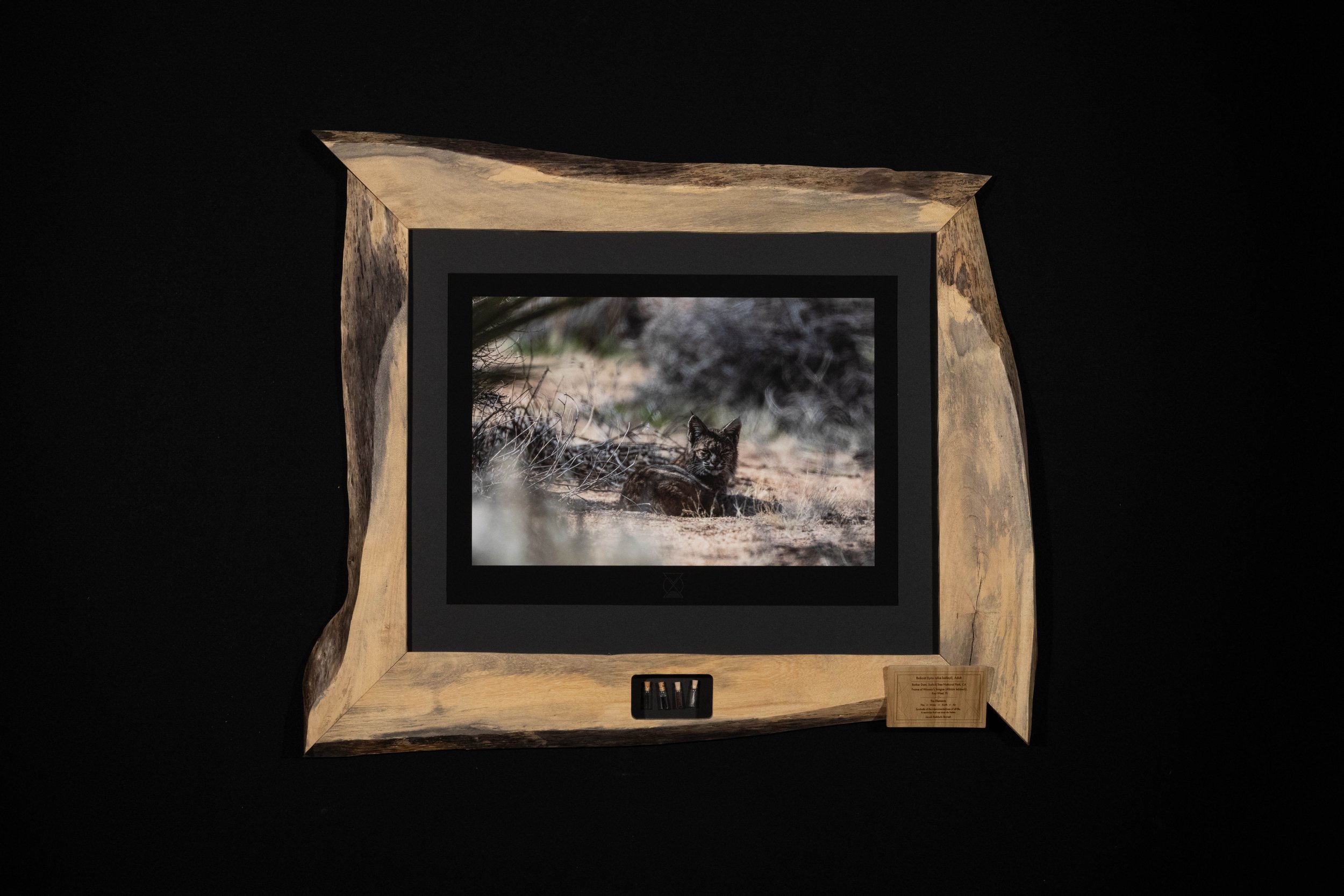Bobcat - Barker Dam, Joshua Tree National Park, CA




Bobcat - Barker Dam, Joshua Tree National Park, CA
Bobcat (Lynx rufus), Adult
Without question this is my favorite photograph I have ever taken. I was able to hang out with this Bobcat for about 15-20 minutes before two other people ended up walking about 100 yards away and scaring it off as they talked and laughed. The Bobcat definitely knew I was there but simply didn’t mind me as it nearly fell asleep multiple times. An incredibly unique experience, the only other place I have ever seen a Bobcat in the wild is in Sanibel, FL when I was a child and a couple quick glimpses in West Virginia. Even more unique, I saw this animal around noon after being out since sunrise and not seeing much of anything. This photo was taken 4/7/2023 at 11:49 am.
WeForest Donation: $320 (What is this?)
Print Number: 1/3
Print Size: 15 x 22.5
Total Dimensions: 35 x 41
Hanging equipment and certificate of authenticity included.
Photograph
Bobcat (Lynx rufus)
The Bobcat, also known as the Red Lynx as its scientific name might suggest, is a very wide ranging animal. Native to an area spanning from the northern most tips of Canada to Southern Mexico, they can be found everywhere in between, from the deserts to the near arctic, to dense forests, to the everglades, they are incredibly adaptable animals. Adept predators, their number one target in nearly all of their habitats is rabbits and hares, however they will hunt many types of birds, insects, reptiles, rodents, and even deer in some places. Like many cat species they live largely solitary lives and are incredibly good at remaining hidden. Although common in many places they are always difficult to see and a special treat for a wildlife lover. Over the course of my life I have spent a lot of time out in nature and can count my run ins with Bobcats that lasted longer than a quick dart in the corner of my eye, on one hand. They are a special species that is just small enough to not yet have befallen the fate of many big cats throughout the world.
Location
Joshua Tree National Park, CA
One of the more recently designated national parks, Joshua Tree National Park, established in 1994, is basically as old as I am. Up there with Sanibel, FL, and Yellowstone National Park, it is also one of my absolute favorite places to take photographs. It is an immense park, located in southeastern California, east of Los Angeles, Joshua Tree includes parts of two deserts, The Mojave and The Colorado. This unique and harsh environment is home to a surprising amount of life, if you are patient and willing to look. Named for the “trees” that dot much of the landscape, the Joshua Tree is actually not a tree at all, but is the worlds largest succulent, which makes sense as they thrive in such arid places. Black-tailed Jackrabbits, and Kit Foxes hide under the branches of these plants, getting shade wherever they can, and Red-tailed Hawks and Crows nest in the branches, some of the few branches that exist across this vast area. This park also contains two oasis where huge fifty foot tall palms grow and yield a very different, although small by comparison, ecosystem. Song birds fly through the rustling palms and temperatures are noticeably cooler. Evidence that coyotes and foxes and bighorn sheep visit these areas are always plentiful but witnessing these excursions to water is not as abundant. I have loved spending time in the park over the past few years and have never been bored by what some might think is a dull/vacant landscape on first glance, it’s not.
Barker Dam
Reached by walking the Barker Dam Trail, this manmade water reservoir in the middle of the desert is most definitely a unique and worthy site. Originally constructed in 1900, it was used by cattlemen in the area for decades, being increased in size and height in 1949. The evidence of this second period of construction is easily visible as you look at the amazingly intact dam wall. A lot of wildlife is in the area as it now acts as a reservoir for the scattered animals of Joshua Tree National Park.
FRAME
Woman’s Tongue (Albizia lebbeck)
Albizia Lebbeck, as it is scientifically known, is native to the Indian subcontinent and Myanmar. It is commonly grown in Australia and other tropic and subtropic places. I get my supply of Woman’s Tongue from Key West, Florida where it is invasive. A wood salvager who has removed the trees from construction sites and properly mills and drys the wood rather than sending it to the dump is my source for a lot of my wood.
THE ELEMENTS
Fire, Water, Earth, and Air
In the display case in the bottom of the frame, four items are preserved glass vials. The items represent the elements: fire (wood charcoal), water (mineral oil), earth (soil), and air (a milkweed seed). I include these items in my work as a symbol of the interconnectedness of all life on earth, and as a reminder that humans must do better.
The Plaque
I engrave a wooden information plaque for each work. The plaque includes what the photograph is of, the location of the photograph, what type of wood the frame is made of and where I got the wood from. The plaques also explain what the vials are in each display case, and even state the meaning of my logo. The plaques are attached magnetically and can be removed to read or to store on the back of each frame if you prefer not to have it displayed on the front.

